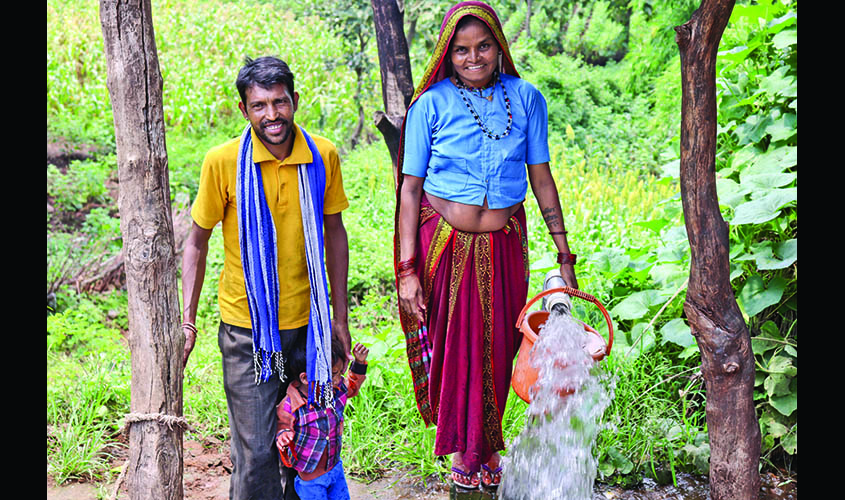Jal Jeevan Mission will improve health outcomes, increase productivity, particularly for women who often travel long distances to get potable water and inevitably contribute to economic growth and prosperity.
One of the most interesting numbers tucked away in the Union Budget documents this year was the financial allocation for the Jal Jeevan Mission, a massive Rs 50,000 crore for 2021-22. It is an almost five times increase from the revised budget estimates of 2020-21 (Rs 11,000 crore) and the actual spend in 2019-20 (Rs 10,000 crore). The Mission, to provide a functional tap water connection to every Indian household by 2024, is the most ambitious social sector programme of Narendra Modi’s second term. When completed, it is likely to be as transformational as the Swachh Bharat Mission of Modi-1.
For most commentators on the economy, India’s transformation is largely viewed through the lens of economic growth. Indeed, economic growth is necessary because ultimately, only that can lead to a sustained rise in the incomes of all Indians, the fundamental requirement for prosperity. The task of achieving sustained high growth is hard, made harder by the current sluggish state of the global economy and the spectre of imminent, rapid technological change. But such is the nature of governance in India, that there needs to be equal focus on generating growth, however challenging, while also taking care of the most basic needs of a large section of the population.
India’s political economy has not always supported the kind of pro-market policies which are required for high growth. But its inherent populism ought to have solved the challenge of meeting universal basic needs. It did not because populism did not focus on efficient, sustained delivery. The Modi government has been trying in earnest to change track: a series of pro-growth reforms have been implemented; and there have been determined attempts to eschew populism and enhance state capacity (with the use of technology) to deliver basic goods and services to the poor.
The Swachh Bharat Mission’s chief task was basic: constructing functional toilets for all Indians. But its impact is more than basic. It is not simply a sanitation programme. It is a health and nutrition programme (absence of toilets breeds disease and malnutrition). It is also a productivity enhancing programme because only a healthy population can become productive economic agents. In the end, it contributes to economic growth.
The Jal Jeevan Mission is equally important. Of course, India ought to have provided clean drinking water to its people many decades ago. This Mission will soon correct that anomaly. Just like Swachh Bharat was not just a sanitation programme, Jal Jeevan is not just a clean drinking water campaign. Again, it will improve health outcomes, increase productivity, particularly for women who often travel long distances to get potable water and inevitably contribute to economic growth and prosperity. Change is already visible in many places where implementation is complete.
The most reassuring aspect of the Jal Jeevan Mission, which points to its sustainability, is revealed in its Vision Statement which states as its aim that “every rural household has drinking water supply in adequate quantity of prescribed quality on regular and long-term basis at affordable service delivery charges leading to improvement in living standards of rural communities.” There is clear emphasis on quality (obvious), on quantity (important, because even in urban areas, water supply is intermittent) and finally on delivery charges. This is not a “freebie” programme. It will charge a fee from users though it will be kept at an affordable level.
The last point is of great importance to the bigger task of managing India’s water resources. A major reason for misuse, whether in agriculture, industry or households, is the improper pricing (or indeed no pricing) of water. It is only when people pay a price for a resource will they have the incentive to conserve it and use judiciously. In fact, government, industry and civil society need to form a constructive partnership to promote the optimal use of water, a precious resource.
One of the other positive outcomes of the focus on Swachh Bharat and Jal Jeevan is the coming to the fore of the Government of India’s Department of Drinking Water and Sanitation, which has been peripheral to most previous governments, often an adjunct to the Ministry of Rural Development. Now, it is set to be responsible for two of the most consequential schemes of the Modi government. Of course, the careful handpicking of bureaucrats to drive the two missions has been key. Parameswaran Iyer was called back from the World Bank, where he had gained considerable expertise on sanitation, and appointed as Secretary of the Department to run Swachh Bharat. For Jal Jeevan Mission, the man in the driver’s seat is Additional Secretary and Mission Director, Bharat Lal, an Indian Forest Service officer from Gujarat, who had done excellent work on water issues when in the state government.
The success of Department of Drinking Water and Sanitation should motivate other ministries and departments, which are viewed as peripheral or unglamorous. India is awaiting many transformations. In that lies an opportunity for every ministry, department
Dhiraj Nayyar is Chief Economist, Vedanta.

